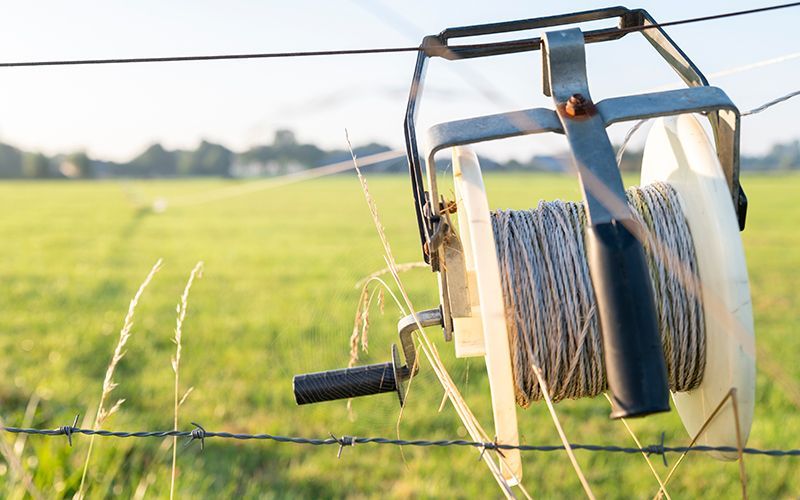
Keeping Your Electric Fence in Top Shape: Repair Tips for New Farmers
|
|
Time to read 4 min
 You are being redirected to QC Supply Pharmacy, where you’ll find a wide selection of high-quality prescription and pharmaceutical products for animals of all sizes.
Enjoy the same great service and expertise you trust from QC Supply.
Click below to continue shopping.
Continue
No thanks, stay on the main site
Powered by
You are being redirected to QC Supply Pharmacy, where you’ll find a wide selection of high-quality prescription and pharmaceutical products for animals of all sizes.
Enjoy the same great service and expertise you trust from QC Supply.
Click below to continue shopping.
Continue
No thanks, stay on the main site
Powered by


|
|
Time to read 4 min
If you’re new to raising animals, especially grazing animals with limited pasture, a portable electric fence will be your new best friend. These amazing innovations in sustainable agriculture become more sophisticated and affordable every year. For the cost of what most farmers would spend on a single tractor payment, you can purchase a system of Poly Electric fence wire, posts, and a Parmak Fencer or Energizer that can turn an otherwise grassy field into a usable pasture for fencing for grazing animals.
By moving these light, restakeable fences around, your fields can be confined and controlled, moving the livestock to new areas daily if so desired. The electric fence energizer can be a solar unit or a plug-in energizer set in one place powered by durable outdoor extension cords. Add a solid grounding rod and portable water tanks and you are ranching.
This system of light, but powerfully strong fencing keeps your land versatile. That versatility of placing fences in areas harder for tractors to get into and set posts (like wetter land, woodlots, oddly shaped hedgerows) allows you to use as much pasture as possible. It also prevents cattle, sheep, poultry, and horses from cherry-picking their favorite bits of fodder in the field instead eating down the entire area. This helps with the economics of grass-fed products like beef and lamb and keeps the stock moving away from soiled fields and possible parasites.
Electric fence maintenance is efficient, cost-effective, and adaptable to many types of agricultural enterprises. But it isn’t perfect and like any system, it requires maintenance. Here are the tools you should have on hand for DIY electric fence repair, fence troubleshooting tips, and field repair tools for fencing as well as some tips for dealing with common problems.
The heart of your system is your energizer. Regardless if you’re working off solar electric fence energizer made for pasture rotation or a wall-mounted, 12 Joule box in your barn, it isn’t something you can ignore. As hearty as those solar cases are in the field they can be covered with debris, mold, sand, or simply left out of a solar-charging area long enough to lose their effectiveness. Every season while taking care of an important task, make energizer maintenance part of your routine.
For example, if it’s time to hose down and re-bed the brooder barn it’s also time to check the energizer’s charge, wiring, and how well it is protected from the elements. Just because your energizer is indoors or under a small covering to keep the rain off doesn’t mean it isn’t affected by humidity, mud splatter, pests, or other wear and tear.
Tip: Always have something simple and portable as a “testing device” for plug-in energizers. For example, a small desk lamp or alarm clock can be carried with you and plugged into the extension cords to troubleshoot areas where the charge seems lost. You can spend hours going over fences and not realize the problem was a bad cord that would have taken minutes to replace.
Every electric fence toolkit should have a reliable fence tester, we recommend the Parmak Professional Digital Fence Tester, to monitor the charge, wire cutters, 3M electrical tape, extra wire, zip ties, spare step-in posts (if necessary), and Kinco leather or rubber gloves. These can all be kept in one bag in your truck; think of them as a first aid kit for your electric fence system. If you use different gauges of wiring, have those spare wire wheels in the kit as well.
Tip: Canvas or cloth gloves can still allow splintering between fibers. Depending on your operation you’ll be troubleshooting in different ways when a fence is down so be prepared for dealing with fiberglass posts that can tear apart hands when they’ve had the sun on them for a few seasons.
Your stock’s habits and the wear and tear on your fencing will be the biggest variable as to whether you should repair or replace it. Discourage this by ensuring you have a strong enough energizer to be successful. Impediments like weeds, downed branches, or trees can short out a ten-mile energizer. If your tester reports low energy on your fence’s charge, it is time to start troubleshooting; searching for problems along your fence line that would hinder the flow.
Tip: Don’t discount wool or long-haired cattle breeds like Scottish Highlanders’ ability to negate electric fences. A sheared spring sheep will be sensitive to a netting fence that a wooly head has no problem lifting up. The same steer whose nose felt the shock of wire may push over three strands of high-intensity fencing with his insulated furry flank.
Making this a habit is the strongest defense in keeping your electric fence operating smoothly. The technology isn’t foolproof, and when working with animals and dealing with the elements, many variables can make even the best systems fail. Monitor it as often as you monitor your cattle, sheep, horses, etc. The fence system you use becomes another creature in your care. Tend to it and reap the rewards of the best technology in the field. Neglect it and you’ll pay the price.
Do you have any great fencing tips or tricks you've learned over the years? Drop a comment below. Do you still have questions, or need help choosing an energizer? Give us a call today at 888-433-5275.